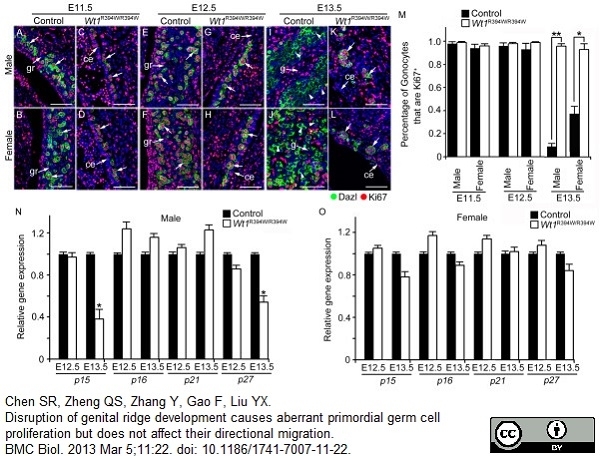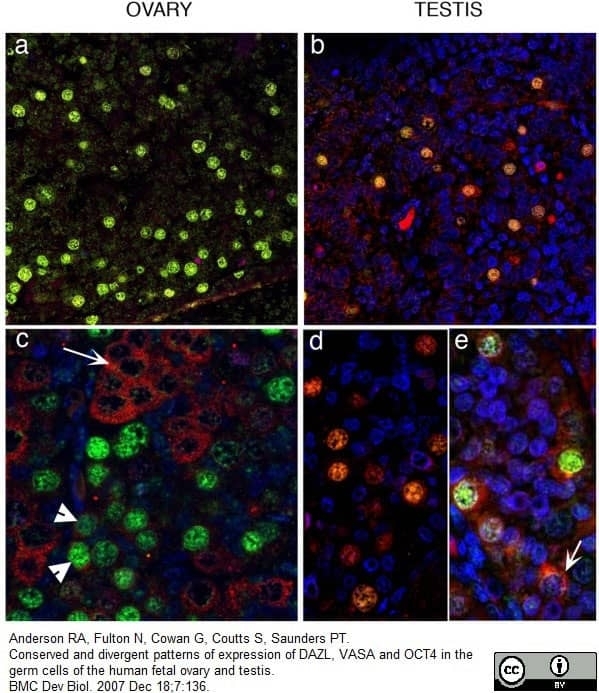DAZL antibody | 3/11A












Mouse anti DAZL
- Product Type
- Monoclonal Antibody
- Clone
- 3/11A
- Isotype
- IgG1
- Specificity
- DAZL
| Mouse anti Human DAZL antibody, clone 3/11A recognizes human Deleted in azoospermia-like, also known as DAZL, DAZ homolog, DAZ-like autosomal, Deleted in azoospermia-like 1 or SPGY-like-autosomal. DAZL is a 295 amino acid ~33 kDa member of the DAZ (deleted in azoospermia) family of RNA binding proteins. DAZL is expressed in fetal and adult testes and ovaries, and is believed to play a role in germ cell development. In adult germ cells, the expression of DAZL is predominantly localized to the cytoplasm. Mutations in this gene have been linked to severe spermatogenic failure and infertility in males (Lin et al. 2001) |
- Target Species
- Human
- Species Cross-Reactivity
-
Target Species Cross Reactivity Mouse Rat Cynomolgus monkey - N.B. Antibody reactivity and working conditions may vary between species.
- Product Form
- Tissue Culture Supernatant - liquid
- Preparation
- Tissue Culture Supernatant containing 0.1M Tris/HCl
- Preservative Stabilisers
- <0.1% Sodium Azide (NaN3)
- Immunogen
- Synthetic peptide corresponding to sequence within the C terminal domain of human DAZL (CRVHHFRRSRAMLKSV).
- Fusion Partners
- Spleen cells from immunised T/O outbred mice were fused with cells of the SP2/0 myeloma cell line.
- Regulatory
- For research purposes only
- Guarantee
- 12 months from date of despatch
Avoid repeated freezing and thawing as this may denature the antibody. Storage in frost-free freezers is not recommended.
| Application Name | Verified | Min Dilution | Max Dilution |
|---|---|---|---|
| Immunofluorescence | |||
| Immunohistology - Paraffin 1 | |||
| Western Blotting |
- 1This product requires antigen retrieval using heat treatment prior to staining of paraffin sections. Sodium citrate buffer pH 6.0 is recommended for this purpose.
- Histology Positive Control Tissue
- Ovary or testis.
References for DAZL antibody
-
Forand, A. & Bernardino-Sgherri, J. (2009) A critical role of PUMA in maintenance of genomic integrity of murine spermatogonial stem cell precursors after genotoxic stress.
Cell Res. 19: 1018-30. -
Elkin, N.D. (2010) Toxicant-induced leakage of germ cell-specific proteins from seminiferous tubules in the rat: relationship to blood-testis barrier integrity and prospects for biomonitoring.
Toxicol Sci.117: 439-48. -
Barrios, F. et al. (2010) Opposing effects of retinoic acid and FGF9 on Nanos2 expression and meiotic entry of mouse germ cells.
J Cell Sci. 123: 871-80. -
Forand, A. et al. (2009) Similarities and differences in the in vivo response of mouse neonatal gonocytes and spermatogonia to genotoxic stress.
Biol Reprod. 80: 860-73. -
Anderson, R.A. et al. (2007) Conserved and divergent patterns of expression of DAZL, VASA and OCT4 in the germ cells of the human fetal ovary and testis.
BMC Dev Biol. 7: 136. -
Aoki, T. and Takada, T. (2012) Bisphenol A modulates germ cell differentiation and retinoic acid signaling in mouse ES cells.
Reprod Toxicol. 34: 463-70. -
Yamauchi K et al. (2009) In vitro germ cell differentiation from cynomolgus monkey embryonic stem cells.
PLoS One. 4 (4): e5338. -
Zogbi, C. et al. (2012) Gonocyte development in rats: proliferation, distribution and death revisited.
Histochem Cell Biol. 138 (2): 305-22.
View The Latest Product References
-
Woods DC et al. (2013) Embryonic stem cell-derived granulosa cells participate in ovarian follicle formation in vitro and in vivo.
Reprod Sci. 20 (5): 524-35. -
Rose CM et al. (2014) Dynamic changes in DNA modification states during late gestation male germ line development in the rat.
Epigenetics Chromatin. 7: 19. -
Chen SR et al. (2013) Disruption of genital ridge development causes aberrant primordial germ cell proliferation but does not affect their directional migration.
BMC Biol. 11: 22. -
Jobling MS et al. (2011) Effects of di(n-butyl) phthalate exposure on foetal rat germ-cell number and differentiation: identification of age-specific windows of vulnerability.
Int J Androl. 34 (5 Pt 2): e386-96. -
Conrad, S. et al. (2014) Differential gene expression profiling of enriched human spermatogonia after short- and long-term culture.
Biomed Res Int. 2014: 138350. -
Wang Y et al. (2015) Protein Arginine Methyltransferase 5 (Prmt5) Is Required for Germ Cell Survival During Mouse Embryonic Development.
Biol Reprod. pii: biolreprod.114.127308. -
Bayne RA et al. (2015) GDF9 is Transiently Expressed in Oocytes before Follicle Formation in the Human Fetal Ovary and is Regulated by a Novel NOBOX Transcript.
PLoS One. 10 (3): e0119819. -
Endo, T. et al. (2015) Periodic retinoic acid-STRA8 signaling intersects with periodic germ-cell competencies to regulate spermatogenesis.
Proc Natl Acad Sci U S A. 112 (18): E2347-56. -
Tian-Zhong, M. et al. (2016) Critical role of Emx2 in the pluripotency - differentiation transition in male gonocytes via regulation of FGF9/NODAL pathway.
Reproduction. 151 (6): 673-81. -
Chen, M. et al. (2019) Abnormal Meiosis Initiation in Germ Cell Caused by Aberrant Differentiation of Gonad Somatic Cell.
Oxid Med Cell Longev. 2019: 8030697. -
Rocha-da-Silva, L. et al. (2019) Expression of genome defence protein members in proliferating and quiescent rat male germ cells and the Nuage dynamics.
PLoS One. 14 (6): e0217941. -
Liang, J. et al. (2019) Induction of Sertoli-like cells from human fibroblasts by NR5A1 and GATA4.
Elife. 8:e48767.
- RRID
- AB_2292585
- UniProt
- Q92904
- Entrez Gene
- DAZL
- GO Terms
- GO:0000166 nucleotide binding
- GO:0005515 protein binding
- GO:0003723 RNA binding
- GO:0005634 nucleus
- GO:0005737 cytoplasm
- GO:0007275 multicellular organismal development
- GO:0007281 germ cell development
- GO:0007283 spermatogenesis
- GO:0008494 translation activator activity
- View More GO Terms
- GO:0045948 positive regulation of translational initiation
MCA2336
If you cannot find the batch/lot you are looking for please contact our technical support team for assistance.
Please Note: All Products are "FOR RESEARCH PURPOSES ONLY"
View all Anti-Human ProductsAlways be the first to know.
When we launch new products and resources to help you achieve more in the lab.
Yes, sign me up










